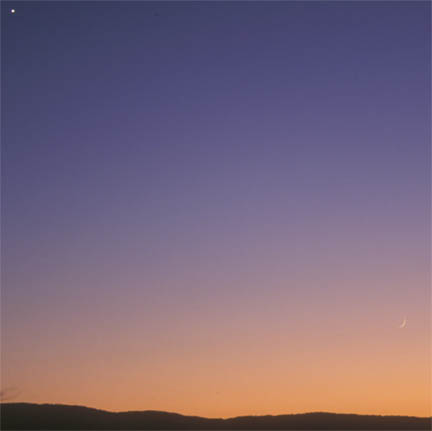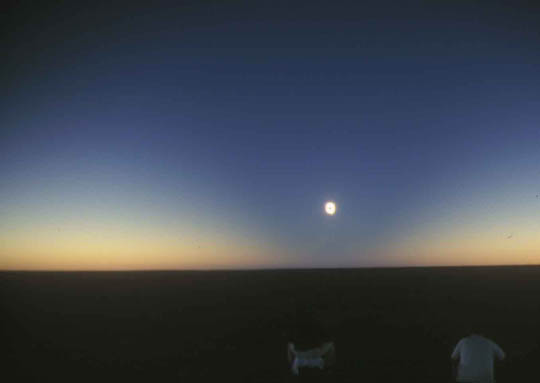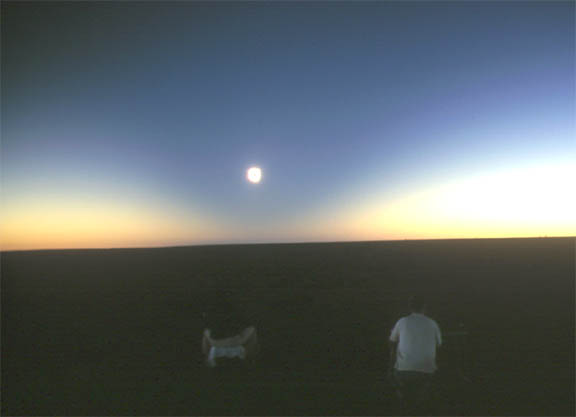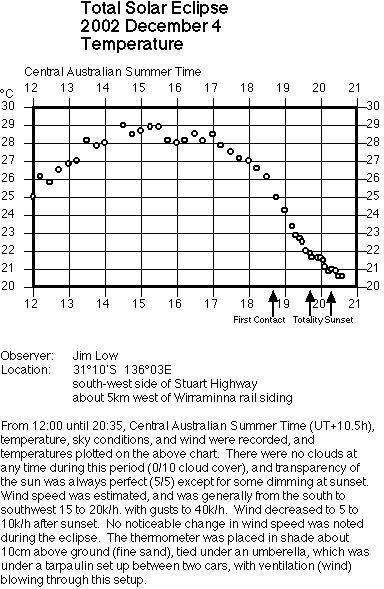
We are up early the day before the eclipse, preparing for the long drive to the eclipse site. I'm at the home of Robert and Betty Price in Bethanga, near Albury, which is on the border between Victoria and New South Wales. Just before sunrise, I glance to the east to see the thin crescent moon. Rarely have I seen the moon so close to the new phase.
Betty drove Robert and me to the home of David Thurley, president of the Astronomical Society of Albury-Wodonga. The three of us make the journey in David's car. Some 1100 kilometres and twelve hours later, we check into the Wilmington Hotel, the best 1-star hotel in Wilmington, South Australia. Certainly it was adequate, and met our needs. We were still almost 300 kilometres from the eclipse site, but was the closest accommodation available. Much of the journey followed the "mighty" Murray River, which marks the boundary between Victoria and New South Wales. It's one of the few rivers I've seen in my month camping through Australia that actually has water in it! Along the journey, I enjoy the scenery, including gum trees and emu. My first sighting of a kangaroo was road-kill. We just missed hitting a kangaroo.
The morning of the eclipse, we complete our journey, passing by Island Lagoon. A beautiful site: a large salt lake with an island in it. The only thing I thought was unusual was the fact there was no water in it. But in Australia, that's normal. But don't be standing on the bottom of a dry lake when it rains anywhere near it. Earlier, I asked someone "what's the largest lake in Australia?" The reply was "That depends what you mean. Dry or with water in it? It depends on the time of year and rainfall."
As we drive, we follow the Trans-Australia Railway and pass through Pimba, where the road splits and one branch leads north to Woomera, the largest community near the eclipse path in that area. We decided on a site near here, because climate records indicated a better chance of no clouds than the coast around Ceduna.
As we cross the south-eastern limit of the path of totality, there is a sign indicating the eclipse path. Driving closer to the central line, we notice people pulling over and setting up. We drive by the Wirraminna rail siding then pull over about five kilometres past it, only about 100 metres east of where we figured the central line passes. This is the true outback. Sand and bushes as far as the eye can see. One would be hard pressed to find a bush over 20 centimetres high. The car is driven about 20 metres off the road, into a clear patch of sand, We selected this spot because the clump of bushes immediately to the west would not be a suitable spot for someone to set up in our line of site to the eclipse
We arrive at 11:30, Central Australian Summer Time (10.5 hours ahead of Greenwich: South Australia and Northern Territory do the same as Newfoundland - make it a half hour difference). Already cars have pulled off the road as far as the eye can see, and it's over seven hours before first contact. One group is constructing scaffolding to view from a hight. As the afternoon progresses, I walk about, finding out where people are from, and getting them to sign my log book. People are from all over the world. Besides Australia, I meet people from Spain, Germany, Switzerland, Italy, and the USA. Although I didn't meet anyone else from Canada, some told me they saw a group flying the Canadian flag about two kilometres down the road. As I had already started my regular eclipse observation program of making temperature observations when I heard about the other Canadians, I couldn't search for them. Okay: who else from the RASC came that I don't know about?
As the time approached first contact, the crowds arrived in earnest. We selected our site well, for no one set up in our line of site for the low eclipse. But there were crowds behind us. Here we are, in "the Red Centre" - the Australian Outback where there are no services whatsoever (no water, electricity, phone services, or toilets), and estimate there are several thousand people within a narrow band along the road, as far as we can see. The sky remained clear all day. Not even a trace of cloud. Transparency was perfect, right to the horizon. The only problem was the wind: averaging about 20k/h all day, with gusts to 40 at times. It was a challenge to keep some equipment in place. The reason this is called "the Red Centre" is because of the very fine red sand - more like dust than sand. Although the wind was not creating a problem in the sky, everything about us became covered in dust. My cushion to sit on was embedded in red dust, and had to be trashed. My Tilley hat is now a shade of red, and it won't wash out (hmmm... am I entitled to a free replacement?). Cameras and other equipment quickly became coated with red dust and had to be regularly dusted off. We saw the occasional "Willy-Willy" which are small dust twirls that look a bit like upside-down cyclones, but not nearly as powerful.
My setup for making temperature recordings was aided by others. Two cars were set up side-by-side, with a tarpaulin between them. I tied my thermometer to an umbrella under the tarpaulin and with the wind blowing through this setup, ensured the thermometer was well ventilated. Accuracy of reading wasn't the goal, only relative change in temperature. We were fortunate this was not a hot day, for we had no shade, except from the cars around us. During the day, the highest temperature was 29.0 degrees at 14:30 Central Summer Time. The temperature slowly dropped to 26.2 just before first contact. It would be normal for temperature to drop during this time of day. As the eclipse progressed, the temperature continued to drop to 21.6 until just after totality at 19:41. Then it levelled off, remaining at that temperature until 20:00, when it continued the drop, reaching 20.8 degrees at sunset at 20:16 and 20.5 degrees at the last observation at 20:35.
Totality was short: predicted at 28 seconds for our location. I was asked by David to call out diamond rings for the benefit of him and others doing photography. This is my eleventh eclipse (8 total, two annular, one "diamond necklace") and both diamond rings were the shortest I have seen, and caught me off guard. For the start of totality, I called "Diamond Ring - remove filters" and before I got to the end of the word "diamond" the Diamond Ring was gone and totality was under way. I had planned to take only one photo during totality with automatic settings, at 28mm, showing the landscape, then just admire totality. I notice the automatic setting comes up with 1/3 second at f5.6. I make the mistake of trying for just one more photo by zooming into the sun for a 200mm photo, and click. Suddenly there was a brief diamond ring and I scream "Diamond Ring - filters on" - again caught by surprise of the short period of diamond ring. Totality was over far too soon - before I had a chance to take a good look at it! "Wait!" I said to myself "I'm not finished yet!" But nature wouldn't wait. "This wasn't 28 seconds" I said to myself. Others said the same thing. Later, however, Robert timed it from his video, and was 30 seconds: not far from the predicted time.
Some people start packing up and leave soon after totality. I guess the partial phase is considered an anti-climax after totality. But we continue to observe. The partial eclipse is still in progress at sunset (20:16). I decide to try photographing the partially eclipsed sun on the horizon, assuming it would be dim enough to photograph at that time without filter. Wrong. It was still very bright as the lower limb of the eclipsed sun touched the horizon, and needed my #14 welders glass to look at it even then. I wait as the partially eclipse sun sinks lower. Just before the last bit of sunlight disappears below the horizon, I look at it through my camera set at 200mm. Within seconds I see the green flash -- am caught totally by surprise -- then press the shutter button just after the green flash disappears. This was my eleventh eclipse but was my first green flash. Shortly after sunset, we pack up and start the drive back to our hotel at Wilmington. This is probably the first time there has been a traffic jam in the outback of Australia. We pull into Spud's Roadhouse at Pimba. There was a long queue for petrol. We pass on getting petrol and go inside and order something to eat. After we manage to place an order for something light and easy to make, we wait an hour before our order was called. We get to the outskirts of Port Augusta as the low fuel warning light comes on, and just make it to an open service station. Reaching the Wilmington hotel about 01:00, Robert and David quickly settle into bed while I go out to the one public phone it town and call home to let folks know what happened. After I finish the phone call, I spend a few minutes admiring the southern sky, before returning to the hotel and bed.
Early the next morning we wake up to total overcast. What perfect timing! Australia needs rain. As we drive back to Albury, we get a few periods of rain, but not enough to end the drought. David drops us off at his house and Betty is waiting to take us back to Bethanga.
At 21:00, looking to the west out of the car window to a clearing sky, I site the moon. This is another first for me. It was the first time I have seen the moon both the day before and the day after an eclipse.
This adventure to Australia has resulted in a number of astronomical "firsts" for me. I have ventured far for many eclipses. Each one is unique, as was this. This was my shortest and lowest total eclipse. It was my first green flash - and it was with a partially eclipsed sun. I had never before seen the moon both the day before and after new moon. It was my first experience at viewing the wonders of the southern sky: the Magelanic clouds, Alpha Centari, Canopus, the Southern Cross. I learned that the strange-looking constellation, popularly known as "the shopping trolley" (shopping cart), is really Orion viewed upside down. Through Robert's 11" Celestron in his observatory, I viewed many brilliant and fine-structured deep sky objects for the first time. When I arrived in Australia over a month ago, I was lost in the southern sky, since so much was unfamiliar and the familiar was upside down. But with the help of Robert, I am starting to learn the new sky. I feel like a kid again, first learning about the heavens.

|
Early morning, on the day before the eclipse, the thin cresent moon was rising over the hills, as seen from the home of Robert Price, in Bethanga, Victoria, just before we left for the eclipse site. The planet Venus is in the upper left. |
|
David Thurley, Robert Price, and Jim Low |
Jim Low about to make a temperature observation. |

|
Wide angle photo (28mm) of totally eclipsed sun, showing shadow of the moon on earth. The light areas on each side represents the atosphere outside of the total eclipse. The photograph below was taken a few seconds later. |

